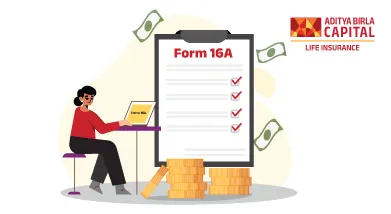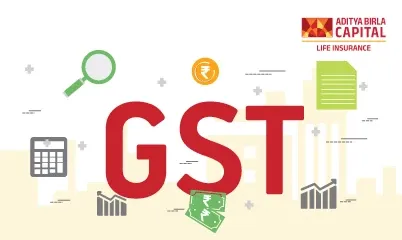Taxes, taxes, taxes! Don't they just love to follow us around? But fear not, tax warriors! Today, we're diving into the world of Form 16A, your trusty companion for understanding and managing taxes on income sources beyond your salary. So, buckle up and get ready to learn everything you need to know about this essential document!
What is Form 16A?
Think of Form 16A as your income report card for any earnings outside your regular paycheck. It's issued by banks, financial institutions, or other deductors when they deduct Tax Deducted at Source (TDS) from your income sources like:
- Interest on fixed deposits
- Commissions earned
- Rent received
- Income from investments like securities
Essentially, Form 16A acts as proof of TDS deducted and deposited with the government on your behalf. It helps you understand how much tax you have paid already and aids in the accurate filing of your income tax returns.
Form 16A Format
Form 16A might seem intimidating at first glance, but understanding its structure makes it much easier to navigate. Here's a breakdown of the key sections:
Part A:
-
Deductor's Details: Name, PAN, and address of the entity that deducted TDS (e.g., bank, mutual fund company).
-
Deductor's TAN: Tax Deduction Account Number specific to the deductor.
-
Assessment Year: The financial year for which the TDS was deducted (e.g., 2023-24).
-
Date of Issue: The date the form was issued.
Part B:
-
Your Details: Name, PAN, address.
-
Nature of Payment: Type of income on which TDS was deducted (e.g., interest, rent, commission).
-
Date of Payment: The date the income was credited to your account.
-
Tax Amount Deducted: The amount of TDS deducted from your income.
-
Gross Amount Paid: The total amount of income before the TDS deduction.
-
Challan Details: Details of the challan used to deposit the TDS with the government (e.g., BSR code, challan number, date of deposit).
Part C:
- Taxpayer's Verification: A space for you to sign and confirm the information provided is accurate.
Additional Information
- Some forms might have additional sections depending on the specific income source and deductor.
- Always refer to the specific format provided by your deductor for any variations.
Why ITR Form 16A Is Necessary?
Form 16A plays a crucial role in your income tax journey for several reasons:
-
Pre-filled Information: When filing your income tax return (ITR), you can pre-fill certain sections with details from Form 16A, saving you time and minimising errors.
-
Accuracy and Reconciliation: It helps you verify the amount of TDS deducted by the deductor and matches it with the TDS information reflected in your Form 26AS (tax credit statement). This ensures accurate tax calculation and avoids discrepancies.
-
Claiming Tax Credit: Form 16A helps you claim the deducted TDS amount as a credit when filing your ITR, reducing your overall tax liability.
-
Supporting Documentation: It acts as supporting documentation for your ITR, proving the amount of TDS deducted and deposited by the deductor. This can be helpful in case of any scrutiny by the tax authorities.
-
Avoiding Penalties: Not claiming TDS reflected in Form 16A can lead to penalties and interest charges. So, it's essential to consider it while filing your ITR.
Remember: While Form 16A is important, it might not cover all your income sources. Ensure you consider all income, including those without Form 16A, while filing your ITR for complete and accurate tax filing.
By understanding the format and importance of Form 16A, you can go through the tax filing process with confidence and ensure a smooth and hassle-free experience.
How to Get Form 16A?
There are two primary ways to get your hands on Form 16A:
1. Download Online:
-
TRACES Portal: If you have a valid PAN and TAN, you can download Form 16A for different financial years and deductors through the TRACES (TDS Reconciliation, Analysis and Correction Enabling System) portal. Here's how:
-
Visit the portal.
-
Log in using your PAN, TAN (optional), password, and captcha code.
-
Go to the "Downloads" section.
-
Select "Form 16A."
-
Choose the financial year, quarter, form type, and PAN.
-
Click "Go."
-
Verify the details and download the form.
-
Deductor's Website or Mobile App: Many banks, financial institutions, and other deductors allow you to download Form 16A directly from their website or mobile app. Check their official website or app for specific instructions and download options.
2. Physical Copy:
-
Deductor's Office: Visit the branch or office of the entity that deducted your TDS (e.g., bank, mutual fund company). They might provide you with a physical copy of Form 16A.
-
Email Request: Some deductors accept email requests for Form 16A. Check their website or contact them directly for their email address and specific requirements for requesting the form.
Important Tips:
-
Ensure you download or request Form 16A for each deductor and financial year.
-
Keep a copy of each Form 16A for your records, preferably both electronically and physically.
-
If you face any difficulties obtaining your Form 16A, contact the respective deductor or seek assistance from a tax professional.
How to Fill in Form 16A?
Fortunately, you don't need to fill in Form 16A yourself! It's already pre-filled by the deductor with all the necessary information. However, there are a few things you should do before submitting it:
-
Verify Information: Carefully review all the details mentioned in the form, including your name, PAN, income type, tax deducted, and challan details. Ensure everything is accurate and matches your records.
-
Sign and Submit: If the form requires your signature, sign and date it in the designated section. Some deductors might accept online submissions through their website or app, while others might require physical submission at their office. Follow the specific instructions provided by your deductor.
Remember: Form 16A is pre-filled and requires minimal action from your end. However, verifying the information and submitting it correctly are crucial steps for accurate tax filing.
By following these guidelines, you can easily obtain and process your Form 16A, ensuring a smooth and hassle-free tax filing experience.
How Do I Use Form 16A To File ITR?
While Form 16A isn't directly submitted with your ITR, it plays a crucial role in ensuring accurate tax filing:
-
Pre-fill Income details: Use the information from Form 16A to pre-fill sections in your ITR related to income from which TDS was deducted (e.g., interest income, rent income). This saves time and minimises errors due to manual data entry.
-
Claim TDS Credit: The TDS amount mentioned in Form 16A helps you claim the tax credit in your ITR. This reduces your overall tax liability by accounting for the tax already deducted at source.
-
Reconciliation with Form 26AS: Compare the TDS details in Form 16A with your Form 26AS (tax credit statement). Any discrepancies require investigation and potential rectification to ensure an accurate tax credit claim.
-
Supporting Documentation: Keep Form 16A handy as supporting documentation in case of any scrutiny by the tax department regarding your TDS claims.
Remember: Even if you don't physically attach Form 16A to your ITR, the information it holds is crucial for accurate and complete tax filing.
How Can I Monitor My Submitted Form 16A's Status?
Since Form 16A isn't directly submitted but used for reference, its status isn't tracked individually. However, you can monitor the TDS reflected in Form 16A through two methods:
- Form 26AS Verification:
-
Access your Form 26AS through the Income Tax Department e-filing portal or your bank's online banking platform.
-
Compare the TDS details mentioned in Form 16A with the corresponding entries in Form 26AS.
-
Any discrepancies might indicate delays in the TDS deposit or errors in reporting.
- TRACES Portal:
-
If you downloaded Form 16A through the TRACES portal, you can view its status under the "Downloads" section.
-
Click on "View Request Status" to see if the form has been successfully processed.
Remember: While there's no specific "submission" for Form 16A, monitoring your TDS details through Form 26AS and TRACES helps ensure everything is accurate and reflected correctly for your tax filing.
Types of Payments for which Form 16A is Issued
| Type of Payment | Description |
|---|
| Interest on Fixed Deposits | Income earned on deposits in banks, post offices, or other notified institutions |
| Commissions | Earnings from selling financial products or services (e.g., insurance agents, mutual fund distributors) |
| Rent Received | Income received from letting out property |
| Winnings from Lottery, Crossword Puzzles, Races, etc. | Any prize money exceeding Rs. 10,000 |
| Payments for Professional or Technical Services | Fees earned for professional services like consultancy, legal advice, etc. |
| Payment to Contractors | Payments made to individuals or firms for undertaking specified work |
| Sale of Immovable Property | Capital gains arising from the sale of land, buildings, etc. |
| Repayment of Deposits under certain schemes | Amounts received upon maturity of certain government or notified schemes |
| Repurchase of Units of [Unit Linked Insurance Plans (ULIPs)](https://lifeinsurance.adityabirlacapital.com/ulip-plan/) | Money received from surrendering ULIP units before maturity |
| Payments to Foreigners | Income paid to non-residents in India |
| Others | As specified by the Income Tax Act |
Note: This list is not exhaustive. Please consult the Income Tax Department website or a tax professional for a complete and updated list
Rate of TDS Deduction in Various Cases of Form 16A
| Type of Payment | Resident Rate | Non-resident Rate |
|---|
| Interest on Fixed Deposits | 10% (if PAN provided), 20% (if no PAN) | 30% |
| Commissions | 10% or tax as per income slab (whichever is higher) | 30% |
| Rent Received | 10% (if PAN provided), 20% (if no PAN) | 30% |
| Winnings from Lottery, Crossword Puzzles, Races, etc. | 30% | 30% |
| Payments for Professional or Technical Services | 10% or tax as per income slab (whichever is higher) | 30% |
| Payment to Contractors | 2% (certain businesses), 5% (others) | 30% |
| Sale of Immovable Property | 20% or tax as per income slab (whichever is higher) | 20% (withholding tax) |
| Repayment of Deposits under certain schemes | As per scheme rules | 30% |
| Repurchase of Units of Unit Linked Insurance Plans (ULIPs)
| 20% | 30% |
| Payments to Foreigners | As per Double Taxation Avoidance Agreement (DTAA) or 30% | As per DTAA or 30% |
Note: These are the base rates. Surcharges and cess might apply in some cases. Please consult the Income Tax Department website or a tax professional for the latest rates and specific exceptions.
Remember: It's always advisable to consult a tax professional for accurate and personalised advice regarding TDS deductions and Form 16A.
When must Form 16A be completed?
Form 16A does not require any completion by the taxpayer. It is issued and pre-filled by the deductor (the entity that deducted TDS from your income) and provided to you. Here's what you need to remember about Form 16A:
-
Issued quarterly: Form 16A is issued every quarter, within 15 days of the due date for filing the quarterly TDS return by the deductor.
-
Pre-filled with information: The form contains details about the deducted TDS, including the nature of income, the amount deducted, challan details, and your PAN.
-
Used for reference: While you don't need to fill anything in Form 16A, you should keep it for your records and use it as a reference while filing your income tax return (ITR).
Difference Between Form 16A and 16:
| Feature | Form 16A | Form 16 |
|---|
| Issued by | Deductor (the entity that deducted TDS from your income) | Employer |
| Purpose | Provides details of TDS deducted on income other than salary | Provides details of salary income and tax deducted |
| Information included | Nature of income, TDS amount, challan details | Salary components, deductions claimed, tax deducted |
| Frequency | Issued quarterly | Issued annually |
| Used for | Claiming TDS credit in ITR | Not directly used in ITR filing, but helps in tax calculation and reconciliation |
| Completion by taxpayer | Not required | Not required |
Comparative Characteristics of Forms 16A and 26AS
| Feature | Form 16A | Form 26AS |
|---|
| Issued by | Deductor (entity that deducted TDS) | Income Tax Department |
| Purpose | Provides details of TDS deducted on specific income | Shows consolidated TDS information from all deductors |
| Information included | Nature of income, TDS amount, challan details, your PAN | All TDS deducted in your name across various sectors, with details like deductors, nature of income, amount, and challan information |
| Frequency | Issued quarterly | Updated quarterly |
| Used for | Claiming TDS credit in ITR, reconciling with Form 26AS | Verifying overall TDS deducted, identifying discrepancies, assessing tax liability |
| Completion by taxpayer | Not required | Not required |
| Accessibility | Available from deductors (download or physical copy) | Accessible through the e-filing portal or the bank's online platform |
| Focus | Specific income source and corresponding TDS | Comprehensive overview of all TDS transactions |
Additional Notes
-
Form 16A acts as a supporting document for the relevant income source mentioned in the form.
-
Form 26AS serves as a master statement for all your TDS deductions, enabling cross-verification and ensuring accurate tax filing.
-
Discrepancies between Form 16A and Form 26AS need to be investigated and rectified before filing your ITR.
Final Thoughts
Understanding the different roles and information provided by Forms 16A and 26AS is crucial for a smooth and accurate tax filing process. By effectively utilising both forms, you can claim your rightful TDS credit, ensure complete tax compliance, and avoid potential discrepancies or penalties. Remember, consulting a tax professional can provide guidance tailored to your specific situation and ensure a stress-free tax filing experience.
Remember, when in doubt, consult a tax professional for personalised guidance and ensure a smooth and accurate tax filing experience.










